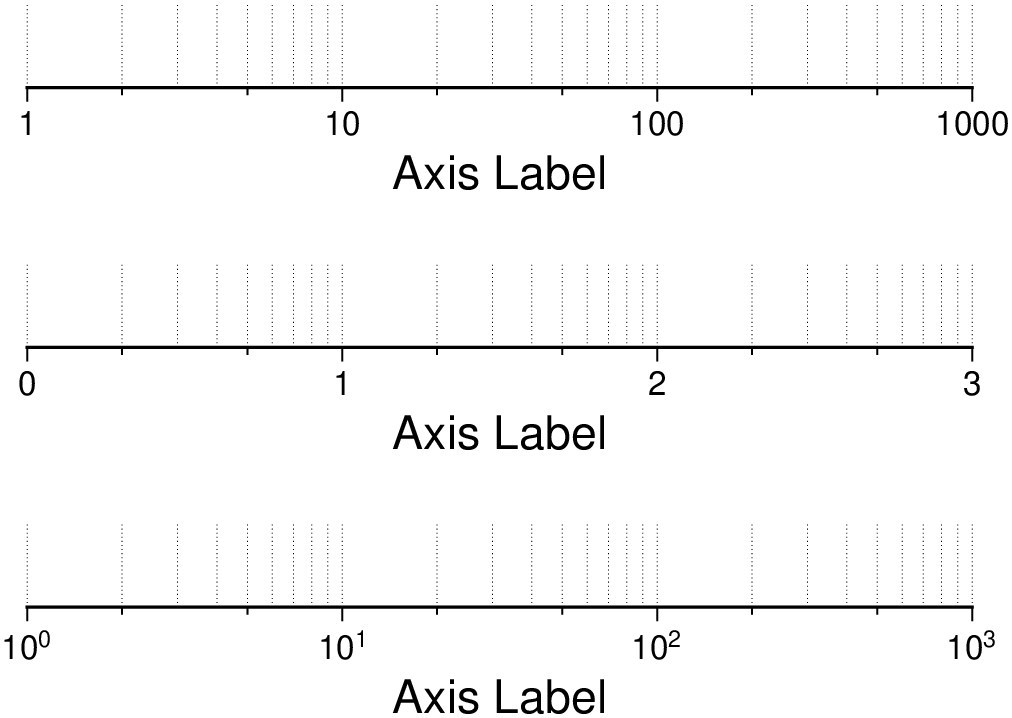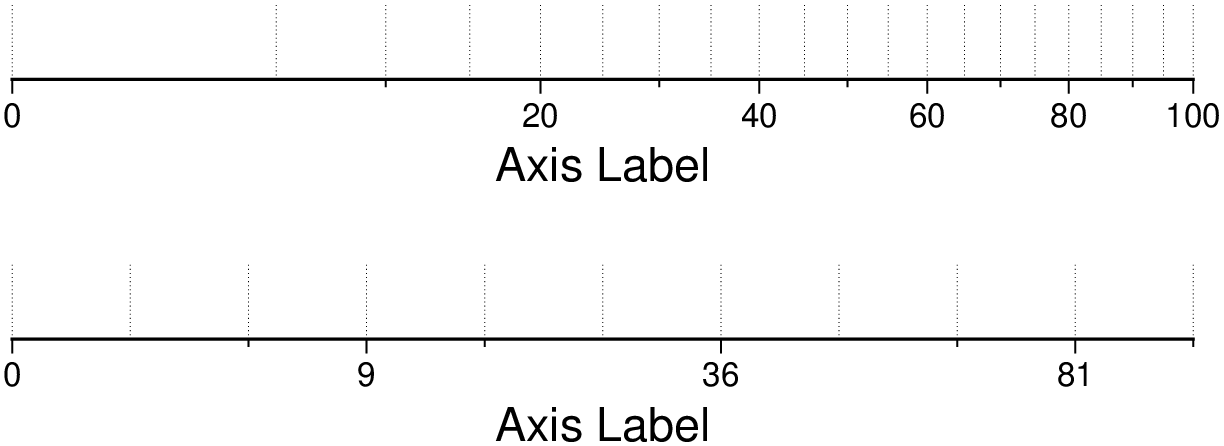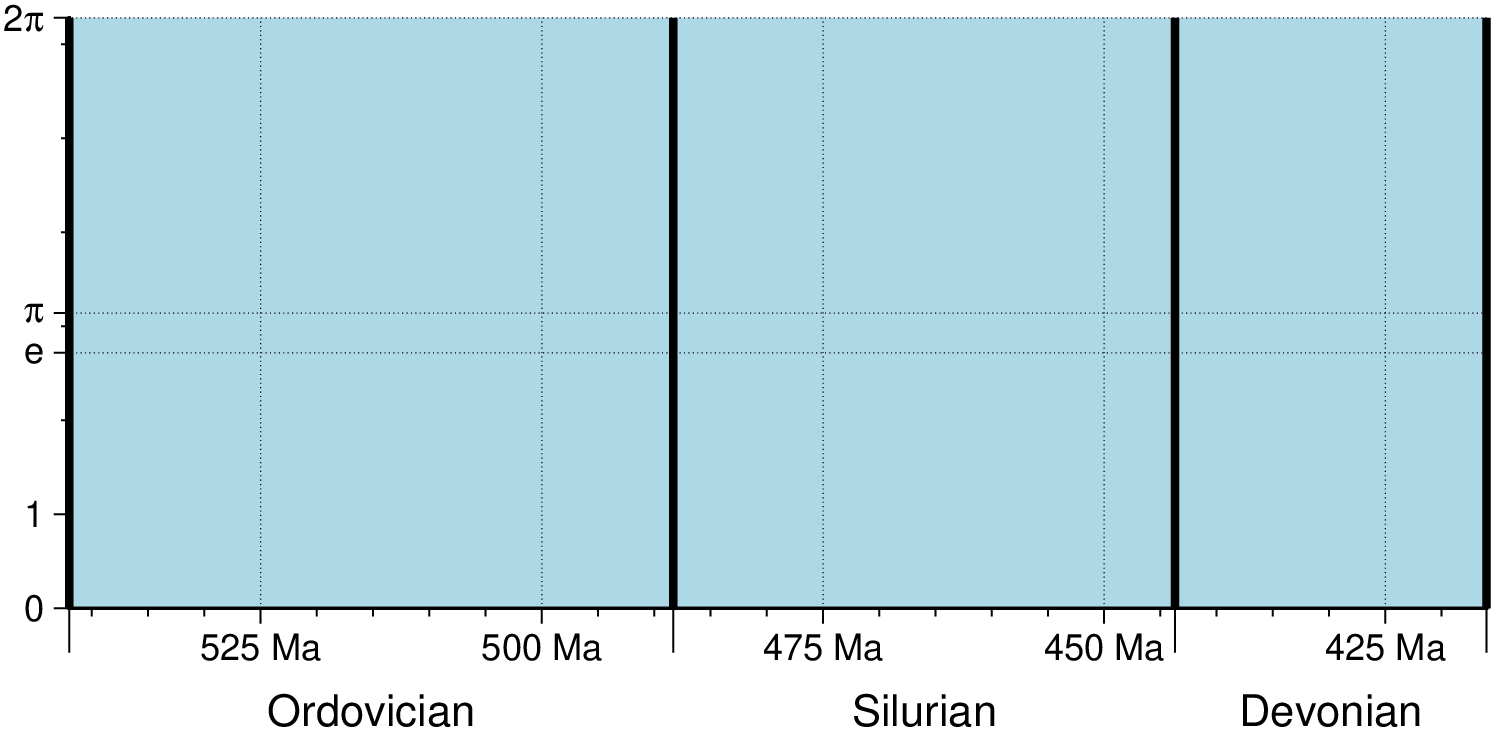Draw Frames
Geographic basemaps
Geographic base maps may differ from regular plot axes in that some projections support a “fancy” form of axis and is selected by the MAP_FRAME_TYPE setting. The annotations will be formatted according to the FORMAT_GEO_MAP template and MAP_DEGREE_SYMBOL setting. A simple example of part of a base map is shown in Figure Geographic map border.
using GMT
basemap(limits=(-1,2,0,0.4), proj=:Mercator, figsize=12,
frame=(axes=:S, annot=1, ticks="15m",grid="5m"))
t = [-1.0 0 0 3.33
0.25 0 0 0.833
1.25 0 0 0.28];
arrows!(t, arrow=(length="2p",start=true,stop=true,angle=60), lw=0.5,
fill=:black, noclip=true, yshift=-0.9)
T = text_record([-0.5 0.05; 0.375 0.05; 1.29166666 0.05], ["annotation", "frame", "grid"]);
text!(T, font=9, justify=:CB, show=true)The machinery for primary and secondary annotations axes can be utilized for geographic base maps. This may be used to separate degree annotations from minutes- and seconds-annotations. For a more complicated base map example using several sets of intervals, including different intervals and pen attributes for grid lines and grid crosses.
using GMT
basemap(region=(-2,1,0,0.35), proj=:Mercator, figsize=10,
frame=(axes=:wSe, annot="15m", ticks="5m",grid="5m"),
axis2=(annot=1, ticks="30m", grid="15m"),
conf=(MAP_FRAME_TYPE="fancy+", MAP_GRID_PEN_PRIMARY="thinnest,black,.",
MAP_GRID_CROSS_SIZE_SECONDARY=0.25, MAP_FRAME_WIDTH=0.2,
MAP_TICK_LENGTH_PRIMARY=0.25, FORMAT_GEO_MAP="ddd:mm:ssF",
FONT_ANNOT_PRIMARY="+8", FONT_ANNOT_SECONDARY=12))
# Draw Arrows and text
t = [-1.875 0 0 0.85
-0.45833 0 0 0.3
0.541666 0 0 0.3]
arrows!(t, arrow=(length=0.08, start=true, stop=true, justify=:center),
lw=0.5, fill=:black, y_offset=-1, no_clip=true)
T = text_record([-2.1 0.025; -1.875 0.05; -0.45833 0.05; 0.541666 0.05],
["10p RM P:", "6p CB annotation", "6p CB frame", "6p CB grid"])
text!(T, font="", justify="", no_clip=true)
t = [-1.5 0 0 3.4; -0.25 0 0 1.7; 0.625 0 0 0.85]
arrows!(t, arrow=(length=0.08, start=true, stop=true, justify=:center),
lw=0.5, fill=:black, y_offset=-0.6, no_clip=true)
T = text_record([-2.1 0.025; -1.5 0.05; -0.25 0.05; 0.625 0.05],
["10p RM S:", "9p CB annotation", "9p CB frame", "9p CB grid"])
text!(T, font="", justify="", no_clip=true, show=true)Cartesian linear axes
For non-geographic axes, the MAP_FRAME_TYPE setting is implicitly set to plain. Other than that, cartesian linear axes are very similar to geographic axes. The annotation format may be controlled with the FORMAT_FLOAT_OUT parameter. By default, it is set to “%g”, which is a C language format statement for floating point numbers, and with this setting the various axis routines will automatically determine how many decimal points should be used by inspecting the stride settings. If FORMAT_FLOAT_OUT is set to another format it will be used directly (.e.g, “%.2f” for a fixed, two decimals format). Note that for these axes you may use the unit setting to add a unit string to each annotation.
using GMT
basemap(region=(0,12,0,1), figsize=(12,1),
frame=(annot=4, ticks=2, grid=1, xlabel="Frequency", suffix="%"),
axis2=(axes="S",))
t = [0 0 0 4.0; 6.0 0 0 2.0; 9.0 0 0 1.0];
arrows!(t, arrow=(length="2p",start=true,stop=true,angle=60),
lw=0.5, fill=:black, y_offset=0.25, no_clip=true)
T = text_record([2 0.2; 7 0.2; 9.5 0.2], ["annotation", "frame", "grid"]);
text!(T, font=9, justify=:CB, clearance=(0.025,0.025), fill=:white, show=true)There are occasions when the length of the annotations are such that placing them horizontally (which is the default) may lead to overprinting or too few annotations. One solution is to request slanted annotations for the x-axis via the slanted keyword in frame.
using GMT
basemap(region=(2000,2020,35,45), frame=(axes=:S, annot=2, ticks=:auto, slanted=-30), show=true)Cartesian log10 axes
Due to the logarithmic nature of annotation spacings, the stride parameter takes on specific meanings. The following concerns are specific to log axes (see Figure Logarithmic projection axis):
stride must be 1, 2, 3, or a negative integer -n. Annotations/ticks will then occur at 1, 1-2-5, or 1,2,3,4,...,9, respectively, for each magnitude range. For -n the annotations will take place every n‘th magnitude.
Append l to stride. Then, log10 of the annotation is plotted at every integer log10 value (e.g., x = 100 will be annotated as “2”) [Default annotates x as is].
Append p to stride. Then, annotations appear as 10 raised to log10 of the value (e.g., 10-5).
using GMT
gmt("set MAP_GRID_PEN_PRIMARY thinnest,.")
basemap(region=(1,1000,0,1), proj=:logx, figsize=(8,0.7),
frame=(axes=:S, annot=1, ticks=2, grid=3, scale=:pow, xlabel="Axis Label"))
basemap!(frame=(axes=:S, annot=1, ticks=2, grid=3, scale=:log,
xlabel="Axis Label"), y_offset=2.2)
basemap!(frame=(axes=:S, annot=1, ticks=2, grid=3,
xlabel="Axis Label"), y_offset=2.2, show=true)Cartesian exponential axes
Normally, stride will be used to create equidistant (in the user’s unit) annotations or ticks, but because of the exponential nature of the axis, such annotations may converge on each other at one end of the axis. To avoid this problem, you can append p to stride, and the annotation interval is expected to be in transformed units, yet the annotation itself will be plotted as un-transformed units. E.g., if stride = 1 and power = 0.5 (i.e., sqrt), then equidistant annotations labeled 1, 4, 9, ... will appear.
using GMT
gmt("set MAP_GRID_PEN_PRIMARY thinnest,.")
basemap(region=(0,100,0,0.9), proj="powx,0.5", figsize=(10, 0.65),
frame=(axes=:S, annot=3, ticks=2, grid=1, scale=:pow, xlabel="Axis Label"))
basemap!(frame=(axes=:S, annot=20, ticks=10, grid=5, xlabel="Axis Label"),
y_offset=2.2, show=true)Cartesian time axes
What sets time axis apart from the other kinds of plot axes is the numerous ways in which we may want to tick and annotate the axis. Not only do we have both primary and secondary annotation items but we also have interval annotations versus tick-mark annotations, numerous time units, and several ways in which to modify the plot. We will demonstrate this flexibility with a series of examples. While all our examples will only show a single x-axis (south, selected via -BS), time-axis annotations are supported for all axes.
Our first example shows a time period of almost two months in Spring 2000. We want to annotate the month intervals as well as the date at the start of each week. Note the leading hyphen in the FORMATDATEMAP removes leading zeros from calendar items (e.g., 03 becomes 3).
using GMT
basemap(region="2000-4-1T/2000-5-25T/0/1", figsize=(12,0.5),
frame=(axes=:S, annot=7, annot_unit=:day_week, ticks=1, ticks_unit=:day_date),
axis2=(annot=1, annot_unit=:month),
conf=(FORMAT_DATE_MAP="-o", FONT_ANNOT_PRIMARY="+9p"), show=true)The next example shows two different ways to annotate an axis portraying 2 days in July 1969:
using GMT
#gmtset(FORMAT_DATE_MAP="\"o dd\"", FORMAT_CLOCK_MAP="hh:mm", FONT_ANNOT_PRIMARY=9)
basemap(region="1969-7-21T/1969-7-23T/0/1", figsize=(12,0.5),
frame=(axes=:S, annot=6, annot_unit=:hour, ticks=1, ticks_unit=:hour2),
axis2=(annot=1, annot_unit=:ISOweekday), par=(FORMAT_DATE_MAP="\"o dd\"", FORMAT_CLOCK_MAP="hh:mm", FONT_ANNOT_PRIMARY=9))
basemap!(frame=(axes=:S, annot=6, annot_unit=:H, ticks=1, ticks_unit=:hour2),
axis2=(annot=1, annot_unit=:date), y_offset=1.7, par=(FORMAT_DATE_MAP="\"o dd\"", FORMAT_CLOCK_MAP="hh:mm", FONT_ANNOT_PRIMARY=9), show=true)The lower example chooses to annotate the weekdays (by specifying a1K) while the upper example choses dates (by specifying a1D). Note how the clock format only selects hours and minutes (no seconds) and the date format selects a month name, followed by one space and a two-digit day-of-month number.
The lower example chooses to annotate the weekdays (by specifying a1K) while the upper example choses dates (by specifying a1D). Note how the clock format only selects hours and minutes (no seconds) and the date format selects a month name, followed by one space and a two-digit day-of-month number.
The third example presents two years, annotating both the years and every 3rd month.
using GMT
basemap(region=("1997T","1999T",0,1), figsize=(12,0.25),
frame=(axes=:S, annot=3, annot_unit=:month, ticks=1, ticks_unit=:month2),
xaxis2=(annot=1, annot_unit=:Y),
conf=(FORMAT_DATE_MAP="o", FORMAT_TIME_PRIMARY_MAP="Character", FONT_ANNOT_PRIMARY="+9p"), show=true)Note that while the year annotation is centered on the 1-year interval, the month annotations must be centered on the corresponding month and not the 3-month interval. The FORMAT_DATE_MAP selects month name only and FORMAT_TIME_PRIMARY_MAP selects the 1-character, upper case abbreviation of month names using the current language (selected by GMT_LANGUAGE).
The fourth example only shows a few hours of a day, using relative time by specifying t in the region option while the TIME_UNIT is d (for days). We select both primary and secondary annotations, ask for a 12-hour clock, and let time go from right to left:
using GMT
basemap(region=("0.2t","0.35t",0,1), figsize=(-12,0.25),
frame=(axes=:S, annot="15m", ticks="5m"), axis2=(annot=1, annot_unit=:hour),
conf=(FORMAT_CLOCK_MAP="-hham", FONT_ANNOT_PRIMARY="+9p", TIME_UNIT="d"), show=true)The fifth example shows a few weeks of time (Figure Cartesian time axis, example 5). The lower axis shows ISO weeks with week numbers and abbreviated names of the weekdays. The upper uses Gregorian weeks (which start at the day chosen by TIME_WEEK_START); they do not have numbers.
using GMT
basemap(region="1969-7-21T/1969-8-9T/0/1", figsize=(12,0.25),
frame=(axes=:S, annot=1, annot_unit=:ISOweekday),
axis2=(annot=1, annot_unit=:ISOweek),
conf=(FORMAT_DATE_MAP=:u, FORMAT_TIME_PRIMARY_MAP=:Character, FORMAT_TIME_SECONDARY_MAP=:full, FONT_ANNOT_PRIMARY=9))
basemap!(frame=(axes=:S, annot=3, annot_unit=:ISOweekday, ticks=1, ticks_unit=:weekday),
axis2=(annot=1, annot_unit=:Gregorian_week),
conf=(FORMAT_DATE_MAP=:o, TIME_WEEK_START=:Sunday, FORMAT_TIME_SECONDARY_MAP=:Character),
y_offset=1.7, show=true)Our sixth example shows the first five months of 1996, and we have annotated each month with an abbreviated, upper case name and 2-digit year. Only the primary axes information is specified.
using GMT
basemap(region=("1996T","1996-6T",0,1), figsize=(12,0.25),
frame=(axes=:S, annot=1, annot_unit=:month, ticks=1, ticks_unit=:day_date),
conf=(FORMAT_DATE_MAP="\"o yy\"", FORMAT_TIME_PRIMARY_MAP="Abbreviated"), show=true)Our seventh and final example illustrates annotation of year-days. Unless we specify the formatting with a leading hyphen in FORMAT_DATE_MAP we get 3-digit integer days. Note that in order to have the two years annotated we need to allow for the annotation of small fractional intervals; normally such truncated interval must be at least half of a full interval.
using GMT
basemap(region=("2000-12-15T","2001-1-15T",0,1), figsize=(12,0.25),
frame=(axes=:S, annot=5, annot_unit=:date, ticks=1, ticks_unit=:day_date),
axis2=(annot=1, annot_unit=:year),
conf=(FORMAT_DATE_MAP="jjj", TIME_INTERVAL_FRACTION=0.05, FONT_ANNOT_PRIMARY="+9p"), show=true)Custom axes
using GMT
basemap(region=(416,542,0,6.2831852), figsize=(-12,5),
frame=(frame=(:left_full, :bot_full), fill=:lightblue),
xaxis=(annot=25, ticks=5, grid=25, suffix=" Ma"),
yaxis=(custom=(pos=[0 1 2 2.71828 3 3.1415926 4 5 6 6.2831852],
type=["a", "a", "f", "ag e", "f", "ag @~p@~", "f", "f", "f", "ag 2@~p@~"]),),)
basemap!(frame=(axes=(:left_full, :bot_full),),
xaxis2=(custom=(pos=[416.0, 443.7, 488.3, 542],
type=["ig Devonian", "ig Silurian", "ig Ordovician", "ig Cambrian"]),),
par=(MAP_ANNOT_OFFSET_SECONDARY="10p", MAP_GRID_PEN_SECONDARY="2p"), show=true)These docs were autogenerated using GMT: v1.33.1













